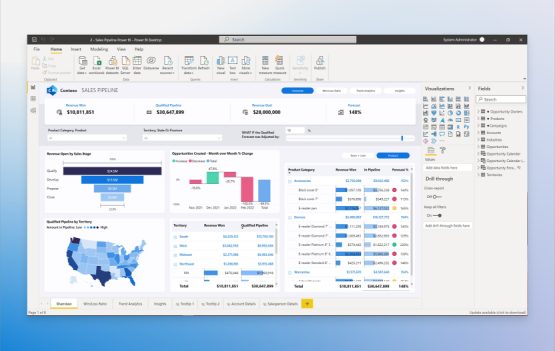Microsoft Power BI
What is business intelligence?
Business intelligence (BI) uncovers insights for making strategic decisions. Business intelligence tools analyze historical and current data and present findings in intuitive visual formats.

How business intelligence works
There are four keys steps that business intelligence follows to transform raw data into easy-to-digest insights for everyone in the organization to use. The first three—data collection, analysis, and visualization—set the stage for the final decision-making step. Before using BI, businesses had to do much of their analysis manually, but BI tools automate many of the processes and save companies time and effort.
Collect & Transform Data from Multiple sources
Business intelligence tools typically use the extract, transform, and load (ETL) method to aggregate structured and unstructured data from multiple sources. This data is then transformed and remodeled before being stored in a central location, so applications can easily analyze and query it as one comprehensive data set.
Uncover trends & inconsistencies
Data mining, or data discovery, typically uses automation to quickly analyze data to find patterns and outliers which provide insight into the current state of business. BI tools often feature several types of data modeling and analytics—including exploratory, descriptive, statistical, and predictive—that further explore data, predict trends, and make recommendations.
Use data visualization to present findings
Business intelligence reporting uses data visualizations to make findings easier to understand and share. Reporting methods include interactive data dashboards, charts, graphs, and maps that help users see what’s going on in the business right now.
Take action on insights in real time
Viewing current and historical data in context with business activities gives companies the ability to quickly move from insights to action. Business intelligence enables real time adjustments and long-term strategic changes that eliminate inefficiencies, adapt to market shifts, correct supply problems, and solve customer issues.

Why companies benefit from using business intelligence tools
Because business intelligence tools speed up information analysis and performance evaluation, they’re valuable in helping companies reduce inefficiencies, flag potential problems, find new revenue streams, and identify areas of future growth.
Some of the specific benefits that businesses experience when using BI include:
- Increased efficiency of operational processes.
- Insight into customer behavior and shopping patterns.
- Accurate tracking of sales, marketing, and financial performance.
- Clear benchmarks based on historical and current data.
- Instant alerts about data anomalies and customer issues.
- Analyses that can be shared in real-time across departments.
In the past, business intelligence tools were primarily used by data analysts and IT users. Now, self-service BI platforms make business intelligence available to everyone from executives to operations teams
Here’s how business intelligence improves the way work is done in six key areas
01
Customer Experience
Access all your customer information in one place, so you can direct resources to key areas that will positively impact customer engagement and support.
02
Sales & marketing
Gain visibility into sales and marketing performance, consumer behavior, and buying trends which ensures future marketing initiatives are effective and drive revenue.
03
Operations
Improve operations by automating routine analytics tasks, refining processes, reducing inefficiencies, and increasing productivity.
04
Finance
Use custom dashboards to get a holistic view of the company’s financial health, study historical data, calculate risk, and predict trends.
05
Inventory control
Automate data analysis and reporting to improve inventory management, accelerate fulfillment, and help anticipate buying trends.
05
Security & Compliance
Centralize data to improve accuracy and transparency, making it easier to uncover errors, security issues, and reduce compliance risks.
When evaluating business intelligence tools, look for a product that’s secure, compliant, globally available, and trusted. It should also have features that make BI insights accessible to your entire organization—such as data visualization, shared dashboards, artificial intelligence, and machine learning.
Real life business intelligence examples
Business intelligence is applied differently from business to business and across a range of sectors—finance, retail and consumer goods, energy, technology, government, education, healthcare, manufacturing, and professional services. Here’s how business intelligence is being used by different industries to achieve success.

Financial Services
A large financial institution in the United Kingdom used business intelligence to connect all its data sources and enable business users as well as IT staff to develop reports and BI solutions, making the business more agile and responsive. Customer service, online banking, and branch staffing are just a few of the teams that now use BI tools to improve efficiency.

Health
A global healthcare solutions provider developed a configuration management system in the cloud to give the company’s IT business operation teams one source of truth for its asset and configuration management inventory. It also integrated the system with a business intelligence tool with advanced visualization capabilities, enabling less technical employees and consumers to quickly get answers to questions.

Manufacturing
A large manufacturing company in the United States deployed a cloud-based business intelligence solution that balanced governance and autonomy in report creation while providing advanced analytics. The cost-effective solution keeps the spirit of self-service alive, while giving IT more control over how and where data is stored, accessed, and maintained.